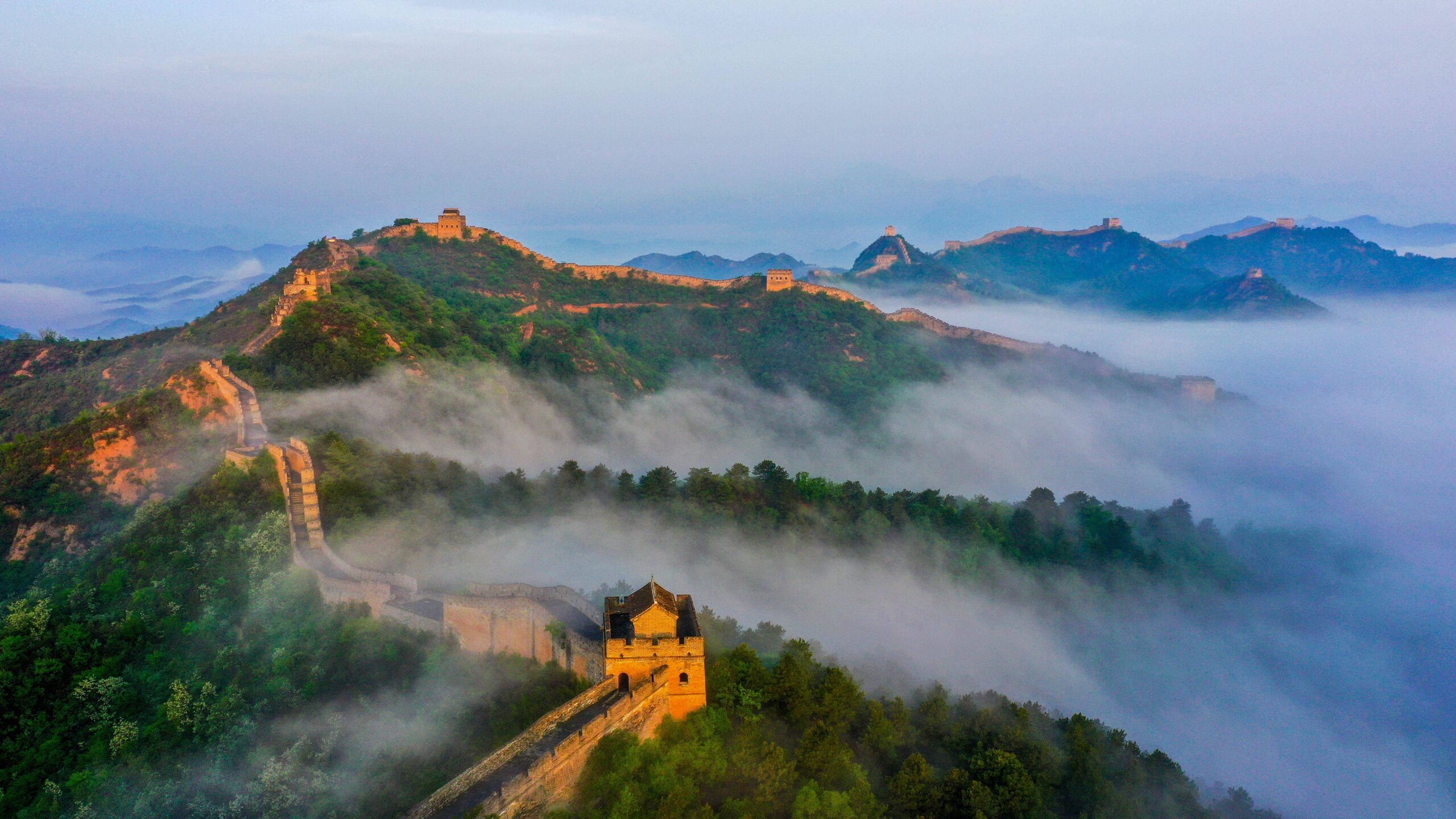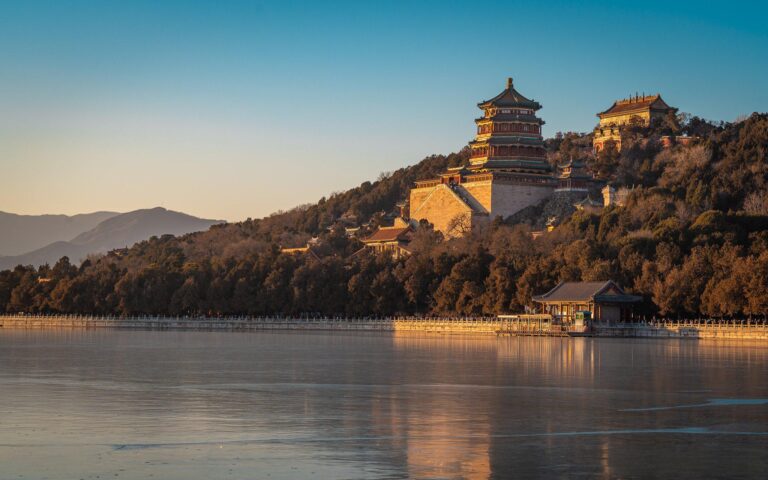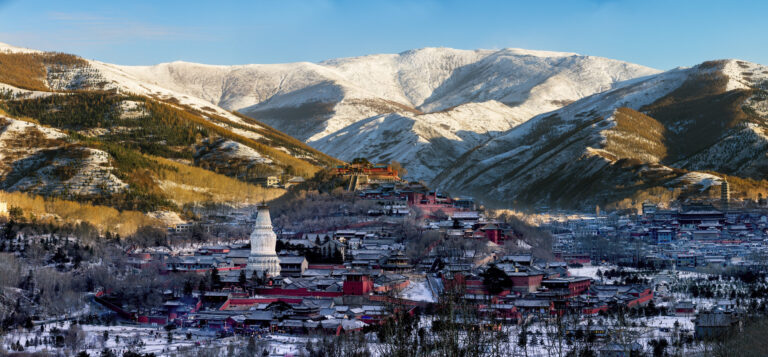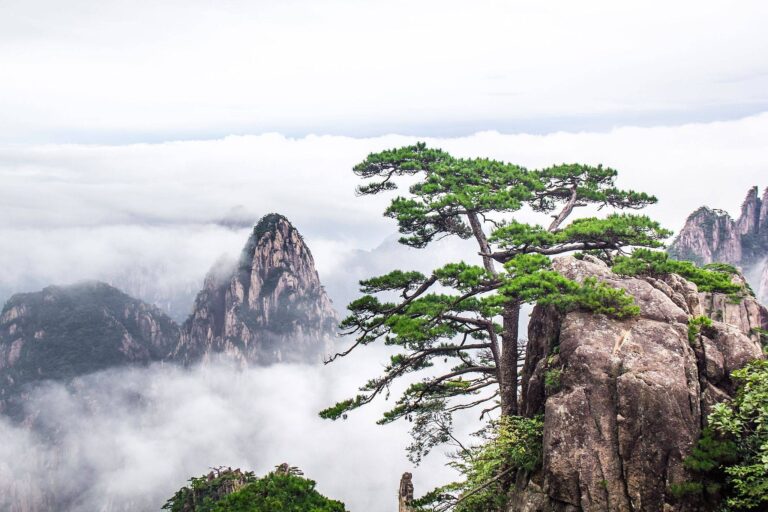Jinshanling Great Wall: The Ultimate Guide to China’s Most Photogenic Great Wall Section
Standing atop the ancient watchtowers of Jinshanling Great Wall, you’ll witness China’s most spectacular fusion of history and natural beauty. This remarkable section offers what many consider the perfect Great Wall experience – dramatic mountain vistas, pristine architecture, and an atmosphere of authentic tranquility that has captivated travelers for decades.
Jinshanling Great Wall, 130 km (80 miles) northeast of central Beijing, is best for hiking and photography among all Great Wall sections. Unlike the crowded Badaling or commercialized Mutianyu, Jinshanling preserves its raw magnificence while providing exceptional accessibility for all fitness levels.
After guiding over 2,000 international visitors through this magnificent section over the past eight years, our team at Travel China With Me has witnessed countless sunrise moments that transform Jinshanling into a golden ribbon stretching across misty mountain peaks. This comprehensive guide shares our deep expertise and insider knowledge to help you experience Jinshanling’s magic responsibly and memorably.
Quick Facts
Location: Luanping County, Hebei Province, bordering Beijing Municipality
Distance from Beijing: 130 kilometers (80 miles) northeast
Construction Period: 1570 CE during Ming Dynasty reign
Total Length: 10.5 kilometers with 67 watchtowers
Elevation: 700-986 meters above sea level
Best Season: April-November for optimal weather and visibility
Difficulty Level: Moderate (suitable for most fitness levels)
UNESCO Status: Part of Great Wall World Heritage Site since 1987
Annual Visitors: Approximately 500,000 (significantly fewer than major sections)
Opening Hours: 8:00am – 6:00pm (March – November)
9:00am – 4:00pm (November – March)
The section features a unique combination of restored and wild portions, creating an authentic experience that photographers and hikers treasure. The watchtowers are positioned at strategic intervals, offering natural rest points and spectacular viewpoints every 500-800 meters along the route.
Table of Contents
History and Cultural Significance
Ming Dynasty Construction Legacy
Jinshanling is a section of Great Wall of China built in 1570 in Ming Dynasty, representing one of the most sophisticated fortification systems ever constructed. The section was built under the supervision of General Qi Jiguang, renowned for his military innovations and strategic Great Wall renovations throughout the northern frontier.
Rulers during the Ming dynasty (1368–1644) ceaselessly maintained and strengthened the Great Wall to prevent another Mongolian invasion. Jinshanling served as a critical defensive position controlling mountain passes between Beijing and northeastern territories.
The construction required over 10,000 workers including soldiers, peasants, and prisoners who labored for five years to complete this section. Archaeological evidence reveals sophisticated engineering techniques including drainage systems, ventilation channels, and strategic positioning that maximized defensive capabilities while minimizing resource expenditure.

Strategic Military Importance
Jinshanling’s positioning reflects brilliant military strategy. The section connects Gubeikou Pass in the west with Simatai in the east, creating an integrated defense system that controlled multiple invasion routes. Each watchtower could communicate with adjacent positions through smoke signals, beacon fires, and flag systems, enabling rapid information transmission across hundreds of kilometers.
The name “Jinshanling” translates to “Golden Mountain Ridge,” referencing both the golden appearance of local limestone and the strategic value of controlling this elevated terrain. Historical records indicate that this section successfully repelled multiple Mongolian incursions throughout the late Ming period.
Cultural Heritage Preservation
Today, Jinshanling represents exceptional cultural heritage preservation. UNESCO recognition acknowledges its outstanding universal value as tangible evidence of Chinese civilization’s architectural and military achievements. The section maintains original Ming-era construction techniques, materials, and architectural features that provide authentic insights into 16th-century Chinese engineering capabilities.
Local communities have maintained ancestral connections to Jinshanling for over 450 years. Traditional knowledge about construction techniques, local legends, and historical events continues through oral traditions that enrich visitor understanding of this remarkable cultural landscape.
Why Jinshanling Great Wall is Worth Your Visit
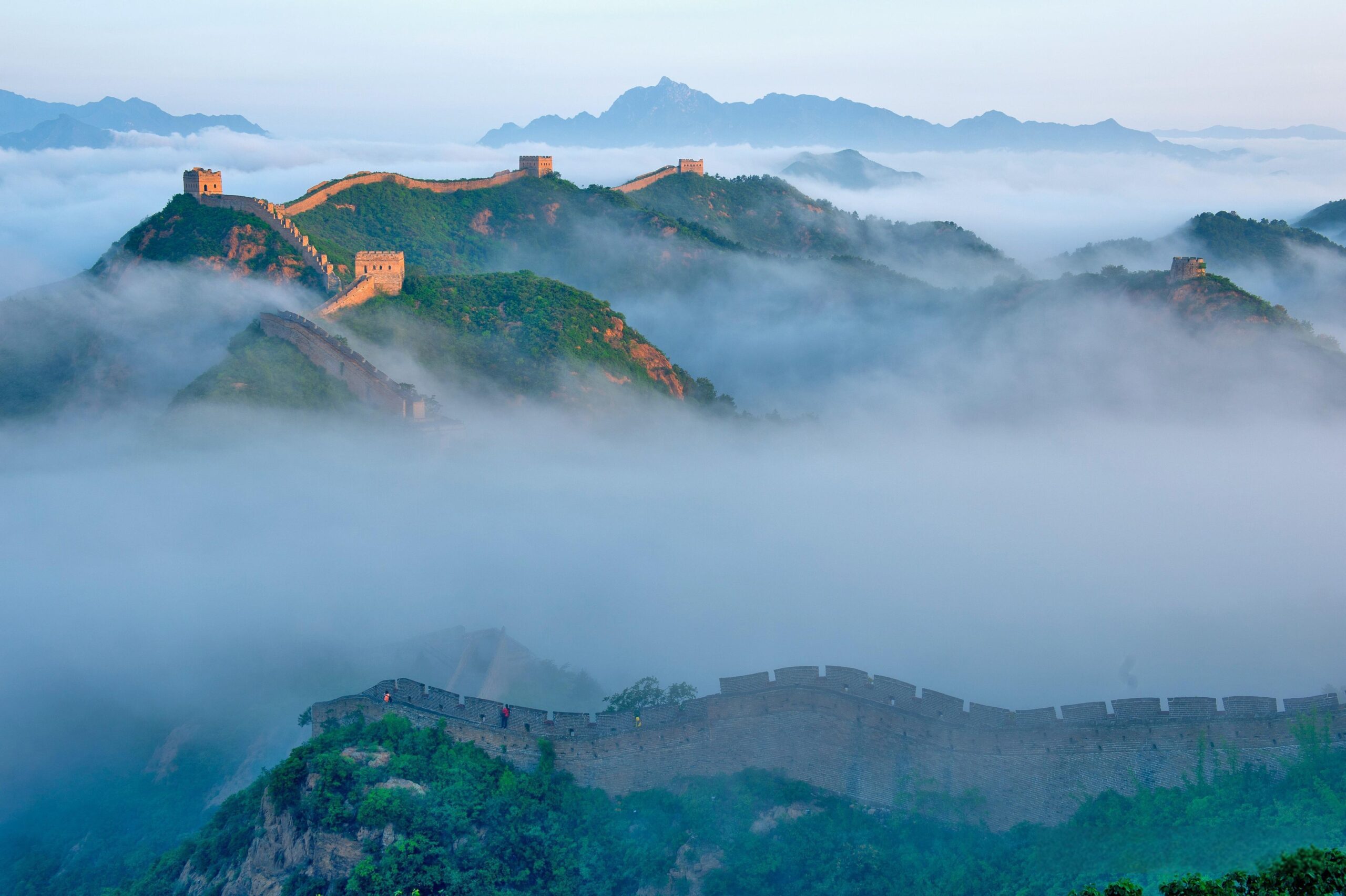
Unparalleled Photographic Opportunities
Professional photographers consistently rank Jinshanling among China’s most photogenic destinations. The section offers dramatic composition opportunities with serpentine wall lines flowing across undulating mountain terrain, creating visual narratives that capture the Great Wall’s legendary grandeur.
Dawn photography at Jinshanling reveals spectacular cloud sea phenomena, where morning mist fills valleys between mountain peaks while watchtowers emerge like islands in a ethereal landscape. Jinshanling opens at 4 am, earlier than sunrise, providing exclusive access for sunrise photography that creates once-in-a-lifetime images.
The interplay between restored and wild sections creates compelling visual contrasts that tell the story of time’s passage and human resilience. Ancient bricks inscribed with Ming-era characters provide intimate details for close-up photography, while panoramic vistas showcase the wall’s monumental scale against pristine natural backgrounds.
Authentic Great Wall Experience
Jinshanling Great Wall delivers authentic Great Wall encounters without overwhelming commercialization. The section maintains original architectural integrity while providing necessary safety infrastructure and visitor services. Unlike heavily commercialized sections, Jinshanling preserves the contemplative atmosphere that allows genuine connection with this extraordinary historical monument.
The hiking experience follows original patrol routes used by Ming-era soldiers, providing authentic insights into daily life and military operations along the Great Wall. Stone steps, doorways, and defensive features remain largely unchanged from their 16th-century configuration, enabling visitors to walk literally in the footsteps of history.
Exceptional Hiking and Adventure
Jinshanling Great Wall offers China’s premier Great Wall hiking experience with varying difficulty levels accommodating different fitness capabilities and time constraints. The main hiking route extends 10.5 kilometers from east to west, providing options for short walks, half-day excursions, or full-day adventures.
The terrain combines moderate climbs with level sections, creating sustainable hiking rhythms that maximize enjoyment while building confidence for less experienced hikers. Strategic watchtower placement provides natural rest points with spectacular viewpoints, ensuring regular opportunities for recovery and photography.
Advanced hikers can explore connecting routes to Simatai West, creating multi-day adventures that showcase different Great Wall sections and architectural styles. Walk west from Simatai West to Jinshanling, stop for the sunset at Zhuanduo Tower represents a classic photography route favored by professional landscape photographers.
Highlights and Must-See Features
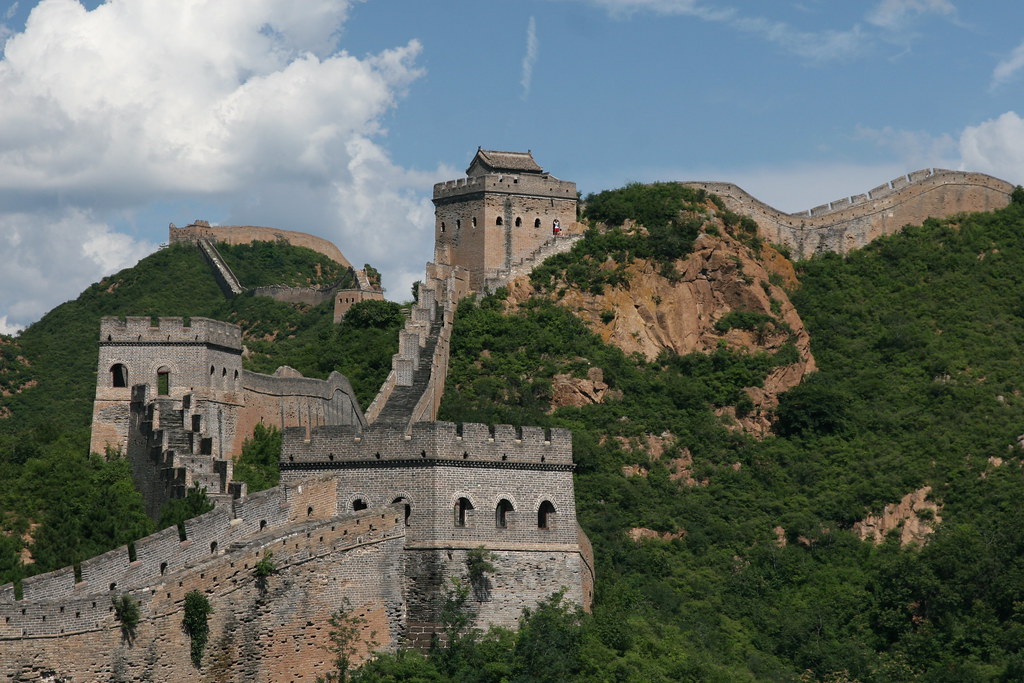
Architectural Marvels
Taochun Tower (General Tower): The section’s highest and most elaborate watchtower features three levels with intricate architectural details including carved stone reliefs, defensive embrasures, and panoramic observation platforms. This tower served as the command center for the entire Jinshanling section.
Zhuanduo Tower: Located at the section’s midpoint, this tower provides the most spectacular panoramic views encompassing both restored eastern portions and wild western sections. The tower’s strategic positioning offers optimal sunrise and sunset photography opportunities.
Big Jinshan Tower: This massive defensive structure showcases sophisticated Ming military engineering with multiple defensive levels, internal courtyards, and advanced fortification features that demonstrate the evolution of Chinese defensive architecture.
Unique Architectural Features
Jinshanling Great Wall displays exceptional architectural diversity with towers ranging from simple observation platforms to complex multi-story defensive structures. The section features different architectural styles reflecting various construction phases and strategic requirements throughout the Ming period.
Original bricks inscribed with manufacturing dates, unit numbers, and craftsmen’s marks provide fascinating insights into Great Wall construction organization and quality control systems. These inscriptions represent invaluable historical documentation that researchers continue studying to understand Ming-era logistics and administration.
The wall’s foundation utilizes sophisticated drainage systems that have preserved structural integrity for over 450 years. Strategic positioning follows natural topography while maximizing defensive advantages, demonstrating advanced understanding of landscape engineering and military tactics.
Natural Integration
Jinshanling Great Wall exemplifies harmonious integration between human architecture and natural landscapes. The wall follows mountain ridges naturally, creating flowing lines that enhance rather than dominate the surrounding environment. This integration reflects Chinese philosophical principles emphasizing harmony between human endeavors and natural systems.
Seasonal changes transform Jinshanling’s appearance dramatically. Spring brings wildflowers and fresh greenery, summer offers lush vegetation and clear mountain air, autumn delivers spectacular foliage colors, and winter creates stark, minimalist compositions with snow-covered watchtowers against grey skies.
Special Experiences at Jinshanling

Sunrise Photography Expeditions
You can camp at the foot of the mountain or stay in the hotel at the tourist center and get up early to see the sun rising up from the sea of clouds on Jinshanling. Professional sunrise photography requires arriving before 4:30 AM to secure optimal positions and prepare equipment for the magical moment when first light illuminates ancient watchtowers.
Our team has documented over 200 sunrises at Jinshanling Great Wall, identifying optimal positions for different seasons and weather conditions. The most spectacular sunrises occur during autumn months when temperature inversions create cloud seas that transform the landscape into an otherworldly vista of watchtowers emerging from misty valleys.
Advanced photographers appreciate the dynamic lighting conditions that change rapidly during the golden hour, creating opportunities for diverse compositions ranging from silhouettes and dramatic shadows to detailed architectural studies with warm, directional illumination.
Cultural Immersion Programs
Local villages surrounding Jinshanling preserve traditional lifestyles and customs that provide authentic cultural experiences. Visitors can participate in traditional farming activities, learn about local folklore related to Great Wall construction, and enjoy authentic regional cuisine prepared using centuries-old recipes.
Village homestay programs offer intimate insights into rural Chinese life while supporting local communities economically. Guests experience traditional courtyard architecture, participate in seasonal agricultural activities, and enjoy evening conversations with families whose ancestors worked on Great Wall construction.
Traditional craft demonstrations include brick-making techniques, stone carving methods, and defensive weapon replicas that illustrate the incredible human effort required for Great Wall construction. These programs provide tangible connections to historical processes and cultural traditions.
Adventure Hiking Routes
East to West Complete Traverse: The full 10.5-kilometer route requires 4-6 hours depending on pace and photography stops. This classic traverse showcases architectural diversity, landscape variety, and historical significance comprehensively.
Sunrise to Sunset Photography Circuit: This specialized route begins with dawn photography sessions, continues through mid-day exploration and architectural study, and concludes with sunset photography from optimal western positions.
Multi-Day Wilderness Camping: Every year, Jinshanling hosts annual hiking events, attracting over 3,000 attendees. Organized camping expeditions provide opportunities for extended Great Wall experiences including night sky photography, traditional campfire programs, and dawn meditation sessions.
Best Time to Visit Jinshanling Great Wall
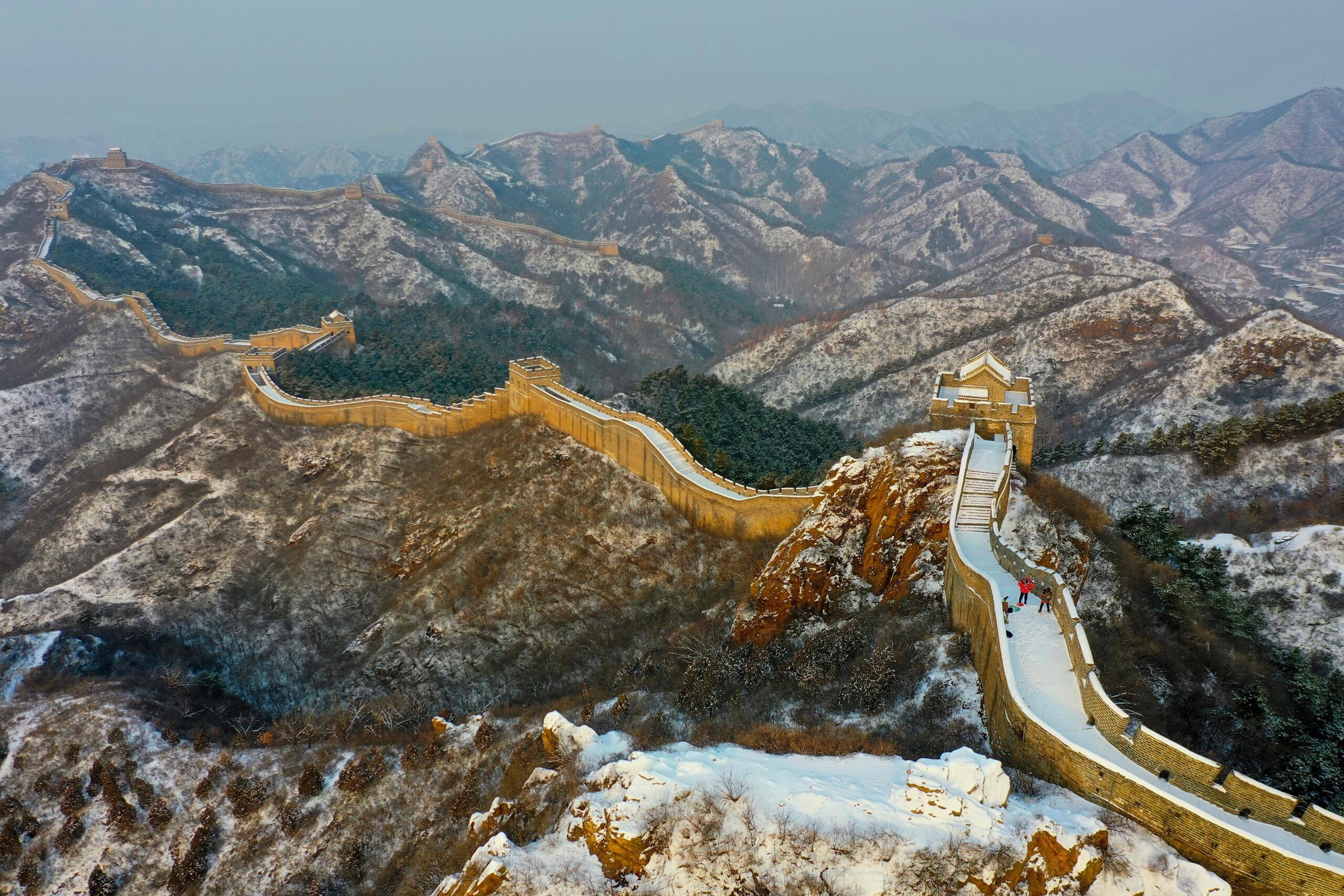
Photo by Zhou Wanping, Xinhua News Agency.
Seasonal Considerations
Spring (April-May): Ideal weather conditions with comfortable temperatures, clear skies, and emerging vegetation. Wildflowers bloom throughout the mountainside, creating colorful foregrounds for photography. Average temperatures range 15-22°C (59-72°F) with minimal rainfall.
Early Summer (June-July): Peak hiking season with warm, stable weather and maximum daylight hours. Vegetation reaches full growth, creating lush green landscapes. Temperatures average 20-28°C (68-82°F) with occasional afternoon thunderstorms that create dramatic sky conditions.
Autumn (September-October): Premier photography season with spectacular foliage colors, crisp air, and exceptional visibility. Temperature inversions frequently create cloud sea phenomena. Comfortable hiking temperatures averaging 12-20°C (54-68°F) with stable weather patterns.
Late Autumn (November): Fewer tourists and dramatic landscapes with bare trees creating minimalist compositions. Clear, cold air provides exceptional visibility for long-distance photography. Temperatures range 5-15°C (41-59°F) requiring appropriate clothing.
Weather Patterns and Visibility
Jinshanling Great Wall experiences continental climate with distinct seasons and significant temperature variations. Weather patterns directly impact visibility, photography conditions, and hiking comfort levels. Understanding seasonal variations enables optimal visit planning.
Morning hours consistently provide the best visibility and photographic conditions regardless of season. Afternoon haze and industrial pollution from distant urban areas can reduce visibility significantly, particularly during summer months. Early morning visits typically offer 2-3 times greater visibility than afternoon periods.
Precipitation patterns vary seasonally with spring and autumn offering the most stable conditions. Summer thunderstorms can create spectacular atmospheric conditions but require flexible scheduling and appropriate safety precautions.
Avoiding Crowds
Visit Jinshanling Great Wall for a peaceful hike away from crowds by choosing optimal timing strategies. Weekdays consistently offer fewer visitors than weekends, with Tuesday through Thursday representing the quietest periods.
Early morning visits before 9 AM and late afternoon visits after 4 PM provide the most solitary experiences. Chinese domestic tourism peaks during Golden Week holidays (October 1-7 and Chinese New Year), school vacation periods, and summer weekends.
Winter months offer the most peaceful experiences with minimal tourist presence, though weather conditions require careful preparation and appropriate equipment.
Planning Your Visit: Getting There, Opening Hours and Tickets

Transportation from Beijing
Private Vehicle/Taxi: Most convenient option requiring 2-2.5 hours via Jingcheng Expressway (G7) to Miyun, then Provincial Road 101 to Gubeikou, and finally local roads to Jinshanling entrance. Total distance approximately 130 kilometers with clearly marked signage.
Public Transportation: Take Bus 980 from Dongzhimen to Miyun, transfer to local buses heading to Gubeikou, then arrange local transport to Jinshanling. Total journey requires 4-5 hours but costs significantly less than private transportation.
Organized Tours: Professional tour operators provide comfortable transportation, expert guides, and comprehensive services including entrance fees, meals, and safety equipment. Tours typically include other regional attractions creating full-day or multi-day experiences.
Hotel Shuttle Services: Some Beijing hotels offer specialized Great Wall shuttle services during peak seasons. These services provide convenient transportation and basic guidance but offer less flexibility than private arrangements.
Entrance Fees and Operating Information
- Admission Fee: 65 CNY (March – November) / 55 CNY (November – March) for standard entrance tickets.
- Shuttle Bus Ticket: One-way – 10 RMB/person, Round-trip – 20 RMB/person
- Cable car: 60 CNY (round trip) / 40 CNY (one way) provides assisted access to elevated sections but may not operate during low season.
Tickets for the Jinshanling Great Wall can be used for a second entry within 48 hours, providing excellent value for photography enthusiasts and extended exploration. This policy enables sunrise and sunset photography sessions during single visits.
Educational groups and senior citizens receive additional discounts with appropriate identification.
Online booking through official channels provides convenience and guaranteed availability during peak seasons. It is recommended that you purchase tickets through a third-party travel agency in advance for international visitors who may experience language barriers with Chinese booking systems.
Facilities and Services
The main entrance area features comprehensive visitor services including parking facilities, restrooms, souvenir shops, and basic medical facilities. Professional photography equipment rental provides cameras, tripods, and specialized lenses for visitors seeking high-quality images without carrying heavy equipment.
Food services range from simple snacks and beverages to traditional Chinese meals featuring local specialties. Regional cuisine includes dishes made with ingredients grown in Great Wall vicinity, providing authentic culinary experiences that complement historical exploration.
Emergency services include first aid stations, communication facilities, and evacuation procedures for medical emergencies or severe weather conditions. Professional guides trained in wilderness safety and Great Wall history provide enhanced experiences for visitors seeking deeper cultural understanding.
Practical Travel Tips
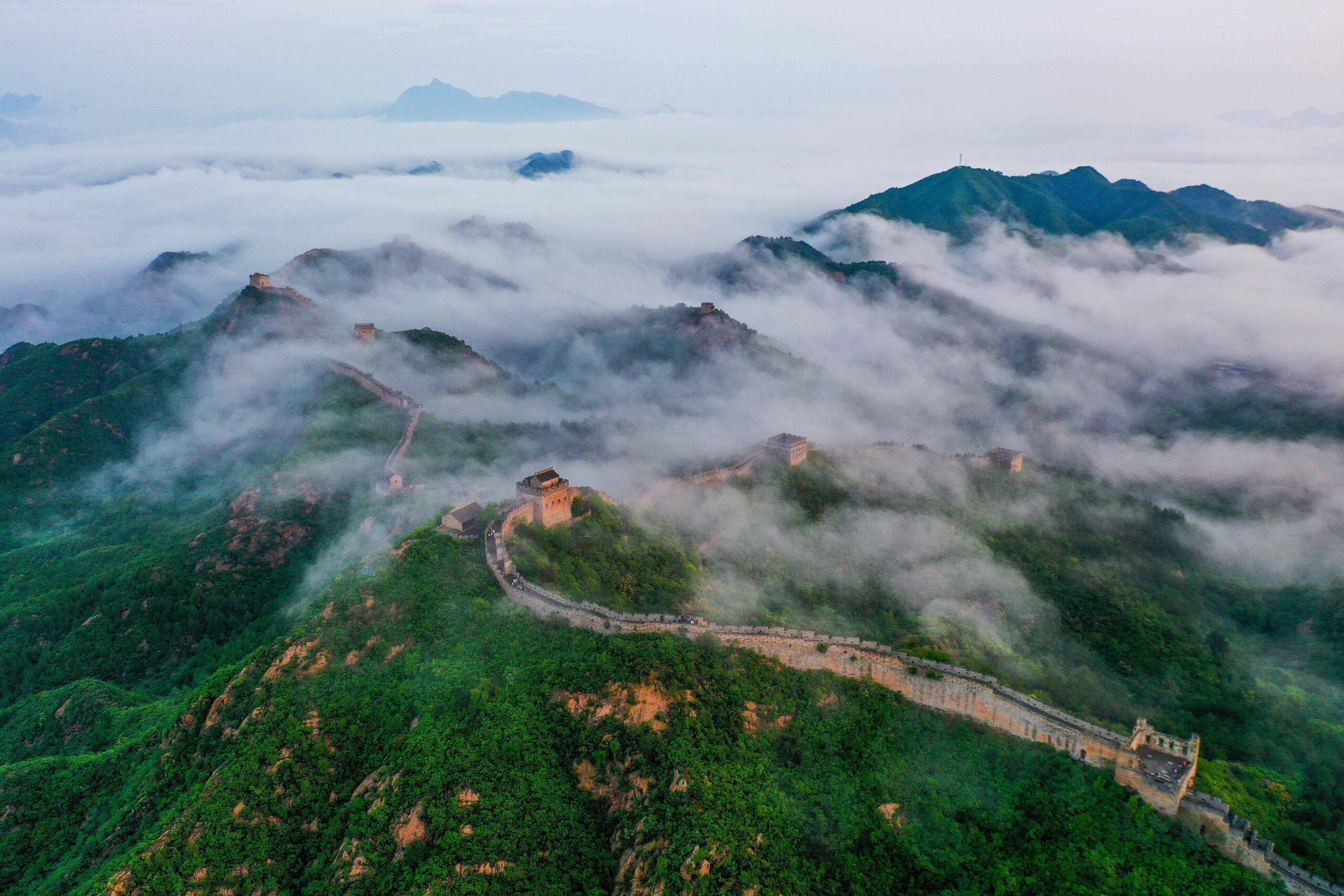
Photo by Zhou Wanping, Xinhua News Agency.
What to Bring
Essential Equipment:
- Comfortable, sturdy hiking shoes with good ankle support
- Weather-appropriate clothing in layers for temperature changes
- Sun protection including hat, sunglasses, and high-SPF sunscreen
- Adequate water (minimum 1 liter per person) and energy snacks
- First aid kit with basic medical supplies and personal medications
- Smartphone or GPS device with offline maps and emergency contact information
Photography Equipment:
- Camera with extra batteries and memory cards
- Sturdy tripod for sunrise/sunset photography
- Wide-angle lens for landscape compositions and telephoto lens for architectural details
- Neutral density filters for long-exposure cloud movement
- Lens cleaning kit for dust and moisture protection
Weather Contingency Items:
- Rain jacket and waterproof covers for electronics
- Warm layers for early morning and late evening temperatures
- Emergency whistle and flashlight for safety
- Cash in small bills for entrance fees and local purchases
Safety Guidelines
Great Wall hiking requires attention to safety protocols and environmental awareness. Ancient stones can be slippery when wet, and some sections feature steep drops requiring careful footing and appropriate caution.
Weather conditions change rapidly in mountain environments. Monitor weather forecasts carefully and be prepared to modify plans if conditions become unsafe. Lightning during thunderstorms poses particular risks on exposed ridges and watchtowers.
Inform others of your planned route and expected return time. Carry emergency contact information and consider hiring local guides familiar with current conditions and potential hazards.
Stay hydrated and recognize signs of altitude sickness, heat exhaustion, or hypothermia depending on seasonal conditions. Rest regularly and don’t push beyond your physical capabilities.

Cultural Etiquette
Respect the historical significance of Jinshanling by avoiding damage to ancient structures. Don’t climb on fragile walls, remove artifacts, or carve names into historic surfaces. Photography is generally permitted but respect any restricted areas or local guidelines.
Interact respectfully with local communities who consider the Great Wall part of their cultural heritage. Learn basic Chinese phrases expressing appreciation and respect. Purchase souvenirs and services from local vendors to support community economic development.
Keep noise levels appropriate for the contemplative atmosphere that many visitors seek. Early morning and evening hours are particularly valued for quiet reflection and spiritual connection with this extraordinary historical monument.
Environmental Responsibility
Practice Leave No Trace principles by packing out all trash and avoiding damage to vegetation or wildlife habitats. Stick to established trails to prevent erosion and habitat disruption.
Water resources are limited in the Great Wall region. Bring adequate supplies rather than relying on local sources. Dispose of grey water responsibly and use biodegradable soaps if necessary.
Support conservation efforts through responsible tourism choices. Choose tour operators and accommodations committed to environmental sustainability and cultural preservation.
Frequently Asked Questions
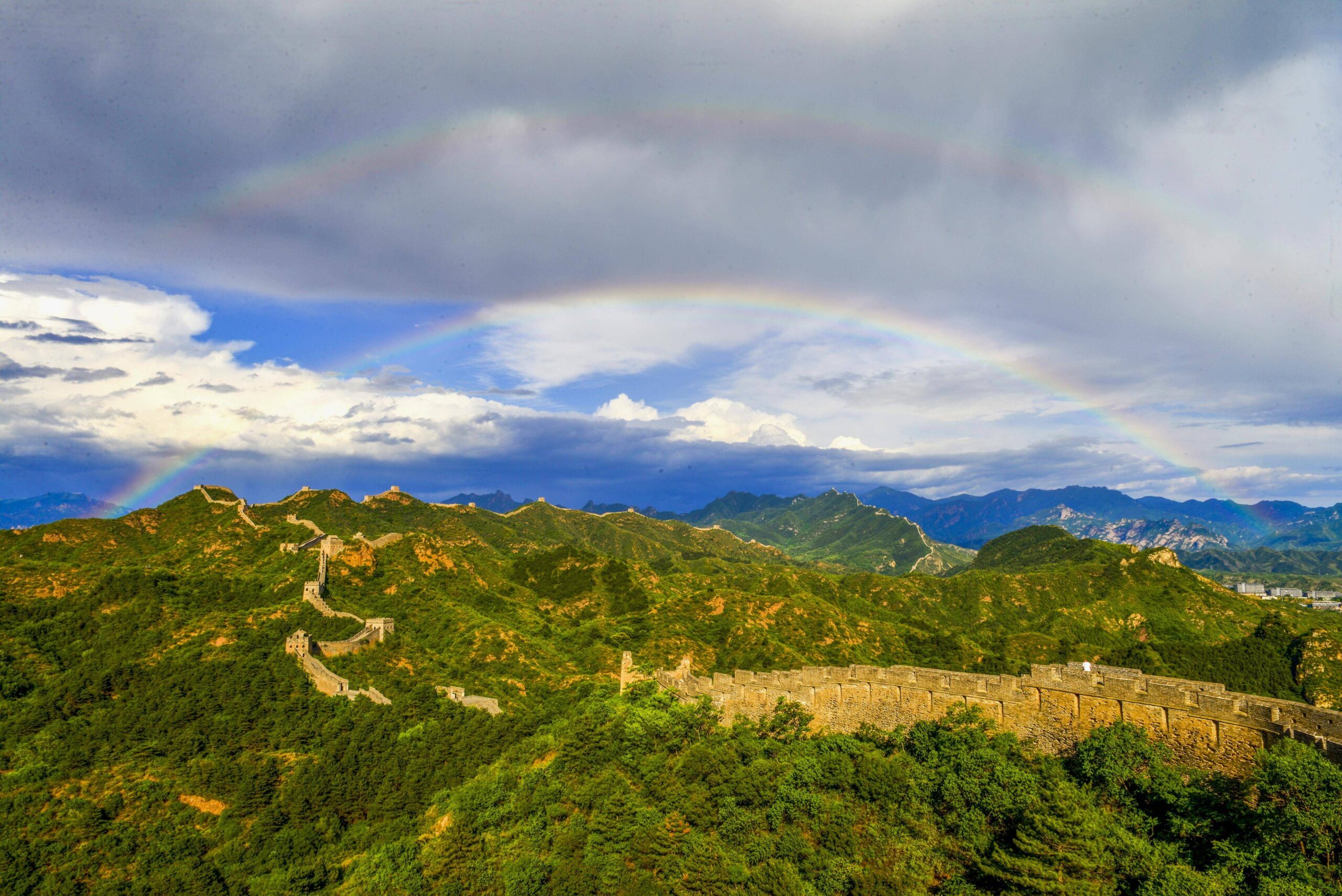
Photo by Zhou Wanping, Xinhua News Agency.
How difficult is the Jinshanling hike?
Jinshanling offers moderate difficulty suitable for most fitness levels. The main route includes gradual climbs and descents with well-maintained stone steps and pathways. Average hiking time is 3-4 hours for the complete section, though visitors can choose shorter segments based on time constraints and physical capabilities.
The steepest sections occur near watchtowers where original Ming-era stairs may be uneven or worn. Taking frequent rest breaks and maintaining steady pacing makes the hike enjoyable for most visitors. Those with mobility limitations can access several viewing areas near the entrance without extensive hiking.
Can I visit Jinshanling independently or do I need a guide?
Independent visits are entirely feasible with proper preparation and basic Mandarin phrases. Clear signage in Chinese and English marks major points of interest and safety information. However, professional guides enhance the experience significantly by providing historical context, cultural insights, and photography assistance.
Guided tours ensure optimal timing for photography, safety awareness, and access to restricted areas that independent visitors cannot enter. Local guides possess intimate knowledge of weather patterns, seasonal changes, and traditional stories that enrich the overall experience.
What’s the best camera equipment for Jinshanling photography?
Wide-angle lenses (14-24mm) capture the wall’s sweeping curves and panoramic mountain vistas effectively. Telephoto lenses (70-200mm) provide excellent detail shots of architectural features and distant watchtowers. A sturdy tripod is essential for sunrise/sunset photography and long-exposure techniques.
Neutral density filters enable dramatic cloud movement photography and balanced exposure in high-contrast lighting conditions. Extra batteries are crucial as cold temperatures drain power quickly. Weather protection for equipment prevents damage from dust, moisture, and temperature extremes.
How cold does it get during winter visits?
Winter temperatures at Jinshanling typically range from -15°C to 5°C (5°F to 41°F) with significant wind chill factors on exposed ridges. Snow and ice create beautiful photographic conditions but require appropriate clothing, footwear, and safety precautions.
Opening Hours: 8:00am – 6:00pm (March – November) / 9:00am – 4:00pm (November – March) with reduced operating hours during winter months. Check current conditions before traveling as extreme weather may cause temporary closures.
Are there accommodation options near Jinshanling?
Several accommodation options serve Jinshanling visitors ranging from basic guesthouses to comfortable hotels near the entrance area. You can camp at the foot of the mountain or stay in the hotel at the tourist center providing convenient access for sunrise photography.
Traditional courtyard accommodations in nearby villages offer authentic cultural experiences with local families. These homestays provide insights into rural Chinese life while supporting community economic development through responsible tourism.
Can children visit Jinshanling safely?
Jinshanling welcomes families with children, though parents should assess their children’s hiking capabilities and attention to safety instructions. The main route includes some steep sections and potential fall hazards that require constant supervision.
Shorter route options near the entrance provide family-friendly hiking experiences without extensive physical demands. Educational programs designed for children help them understand Great Wall history and cultural significance through age-appropriate activities and storytelling.
What should I do if weather conditions deteriorate during my visit?
Monitor weather forecasts before and during your visit. If thunderstorms develop, seek immediate shelter in watchtowers or visitor facilities. Avoid exposed ridges during lightning activity and be prepared to end your hike early if conditions become unsafe.
Staff members monitor weather conditions and will close sections if necessary for visitor safety. Have contingency plans including alternative indoor activities or delayed visits if weather prevents safe Great Wall exploration.
A Personal Note from Our Team

After 20+ years of guiding international visitors through Jinshanling’s ancient pathways, our passion for this extraordinary section of the Great Wall continues growing with each sunrise we witness from its weathered watchtowers. We’ve seen proposal ceremonies on misty morning ridges, watched children take their first steps on Ming Dynasty stones, and shared quiet moments of reflection with travelers from every continent.
What makes Jinshanling truly special isn’t just its stunning architecture or dramatic landscapes—it’s the way this place connects us across centuries to the dreams, struggles, and achievements of people who built something so magnificent that it still takes our breath away 450 years later. Every inscribed brick tells a story, every weathered stone pathway holds memories of soldiers who walked these same routes under the same stars we see today.
Our commitment at Travel China With Me extends beyond simply showing you beautiful places. We believe in creating transformative experiences that foster deep cultural understanding, environmental appreciation, and personal growth through authentic engagement with China’s most significant historical monuments.
Jinshanling has taught us that the most profound travel experiences occur when we move beyond surface tourism to genuine cultural exchange. When you stand on these ancient walls at dawn, watching mist rise from valleys that have remained unchanged for millennia, you’re not just visiting a tourist attraction—you’re participating in a conversation between past and present that defines what it means to be human.
We invite you to experience Jinshanling not as spectators but as temporary custodians of this incredible heritage. Walk thoughtfully, photograph respectfully, and carry forward the responsibility to preserve and protect this irreplaceable gift for future generations who will stand where you stand today, feeling the same sense of wonder and connection that has moved visitors for decades.
Contact our team at Travel China With Me to begin planning your personalized Jinshanling adventure. We’ll help you create memories that will last a lifetime while ensuring your visit contributes positively to the preservation and appreciation of this extraordinary testament to human achievement and natural beauty.


